Tonight, the night sky will be lit up by a once-in-a-lifetime spectacle as the ‘Mother of Dragons’ comet returns to the solar system.
The 21-mile-wide (34km) comet 12P/ Pons-Brooks, or Pons-Brooks for short, is making its first visit to the inner solar system in more than 70 years.
And the great news is that you won’t even need a telescope or any special equipment to see this stunning display.
All you will need is a dark night and some patience to spot the Mount Everest-sized comet with the naked eye as it reaches its brightest point on Sunday.
However, Dr Robert Massey, deputy executive director of the Royal Astronomical Society warns: ‘Don’t expect it to be dazzlingly bright – the kind of image you see in photographs. It’s not going to be like that.’
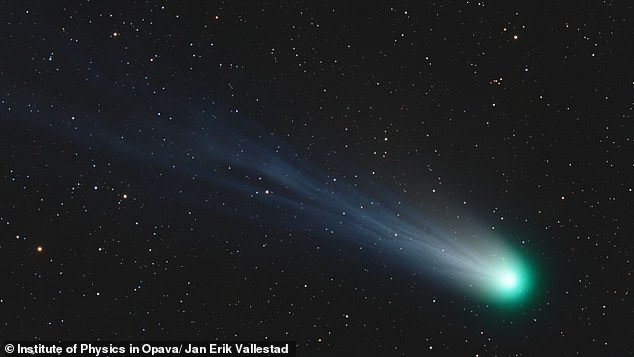
Tonight the dazzling green ‘devil comet’ (pictured) might be visible with the naked eye over the UK
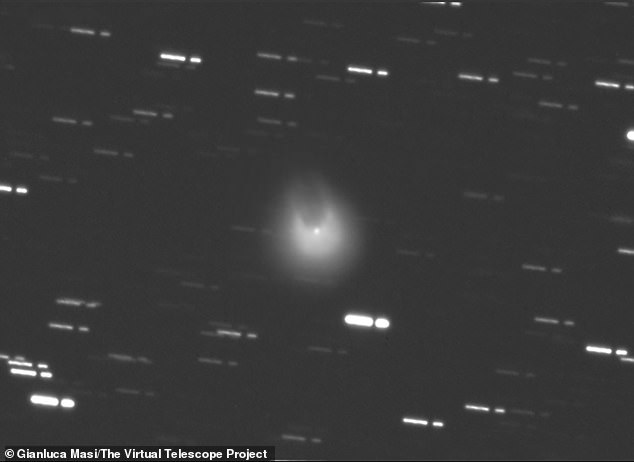
The comet earned its name as an eruption of the comet’s ice volcanoes gave it a distinct horn-like appearance
The Pons-Brooks comet is a periodic comet, meaning its orbit takes it through the solar system on a somewhat regular basis.
It takes 71.3 years for it to make a complete lap of the sun, making it a so-called Halley-type comet which appear in the solar system every 20 to 200 years.
This means opportunities to see the devil comet only come once or maybe twice in a lifetime.
As Pons-Brooks returns to the inner solar system, light from the sun will reflect off the comet’s cloud of gas and ice – making it appear to glow brighter.
The comet will reach its maximum brightness as it reaches its closest point to the sun, or its apogee, which will take place tonight.
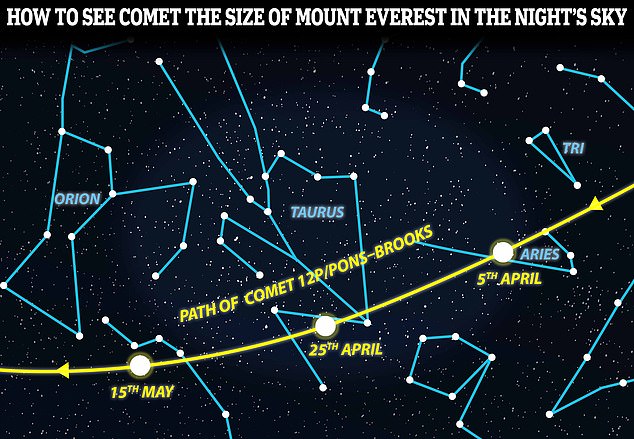
To see the comet this weekend look to the West in the 90 minutes after sunset, the comet should be below and to the left of Jupiter
At this time the comet might become bright enough to see with the naked eye, although it will still be very faint.
Dr Massey says: ‘This is something that might just be visible to the naked eye if you don’t have a Moon in the sky, if there’s no light pollution and if the weather is really clear, then you might stand a chance.
‘But for most of us, we’re going to need to pick up a pair of binoculars.’
Since it might be hard to spot, Dr Massey recommends using a star chart or night sky app to help locate it.
Jake Foster, astronomy at the Royal Observatory Greenwich, told MailOnline: ‘The comet will appear low in the west after sunset, setting below the horizon around 90 minutes after the Sun does.
‘This means it will be difficult to observe, but not impossible. It will be just below and to the left of Jupiter, which will appear as a bright white dot to the naked eye.
Although the comet will be at its brightest, it may still be quite hard to see as the lighter evenings reduce its visibility.
Mr Foster says: ‘Spotting the comet will require a clear view of the western horizon and a pair of binoculars or a telescope.
‘Getting away from the light pollution of bright city lights will also help.’
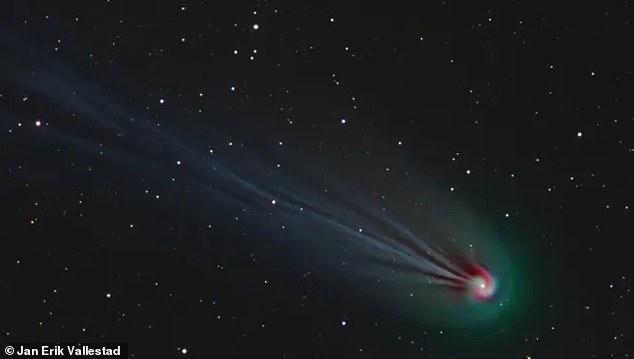
The comet should be visible as a white spot to the naked eye, while telescopic photographs like this can reveal the swirling clouds of gas and dust that surround the nucleus
If you are lucky enough to get a good view of the comet this weekend, you might be able to see a detail that makes Pons-Brooks particularly special.
As the comet approaches the sun it glows with an eerie green light which is visible through a telescope.
‘The comet’s fuzzy green glow comes courtesy of diatomic carbon molecules (basically pairs of carbon atoms stuck together) on its surface,’ Mr Foster explains.
‘As the comet gets closer to the Sun, the Sun’s radiation breaks the molecule bonds apart, releasing energy as vibrant green light.’
Pons-Brooks is also one of the few known cryovolcanic comets, meaning it regularly erupts with plumes of dust and ice.
Beneath the icy surface, the comet has a core of cold ‘magma’ made of liquid hydrocarbons and dissolved gasses.
As it is warmed by the sun, pressure builds up inside which eventually erupts with dramatic results.
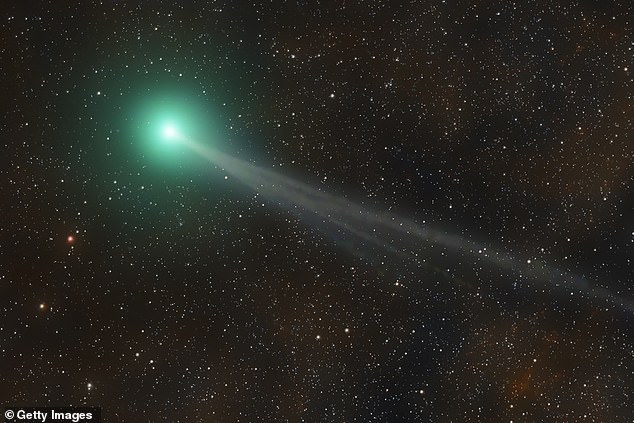
12P/Pons-Brooks can appear to have a fuzzy green glow due to the presence of diatomic carbon molecules on its surface. These absorb energy from the sun and release it as green light
It was one of these eruptions which gave the comet its ‘devil horn’ appearance as a plume of dust created a second tail.
An eruption in July 2023 also caused the comet to become 100 times brighter from Earth, and more flare-ups are possible as we move through the month.
However, it isn’t likely that these flares will be big enough to make the comet significantly brighter to the naked eye.
Like many periodic comets, Pons-Brooks has a long history of observation with the first recorded sighting likely dating back to 14th century China.
However, it wasn’t until the 1800s that Pons-Brooks was recognised as a comet.
French astronomer Jean-Louis Pons, who is the most prolific visual comet discoverer of all time, first spotted the object in 1812.
Pons’ observations were confirmed in 1883 by British-born American comet observer William R. Brooks.
The comet is named after these two astronomers and gets the title 12P on account of being the 12th periodic comet to be discovered.
The comet is also sometimes called ‘The Mother of Dragons’ because it is believed to be the origin of the draconic meteor shower which occurs between November and December.
Other comets to see
If you don’t quite manage to see the 12P/Pons-Brooks comet this weekend, there is still hope for the rest of the year.
In 2024, we will be treated to two more comets that should be bright enough to spot with binoculars or the naked eye.
Between June and July, the 13P/Olbers comet will return to the solar system for the first time in 69 years.
This Halley-type comet won’t be the brightest but it should be visible to careful observers in the Northern hemisphere with binoculars.
Through September and October, however, stargazers will be in for a real treat as C/2023 A3 makes its way to the inner solar system.
At its peak, it is believed that this comet could rival Sirius as the brightest object in the night sky.
It will be easily visible to the naked eye and there will be good views all month, weather permitting.











